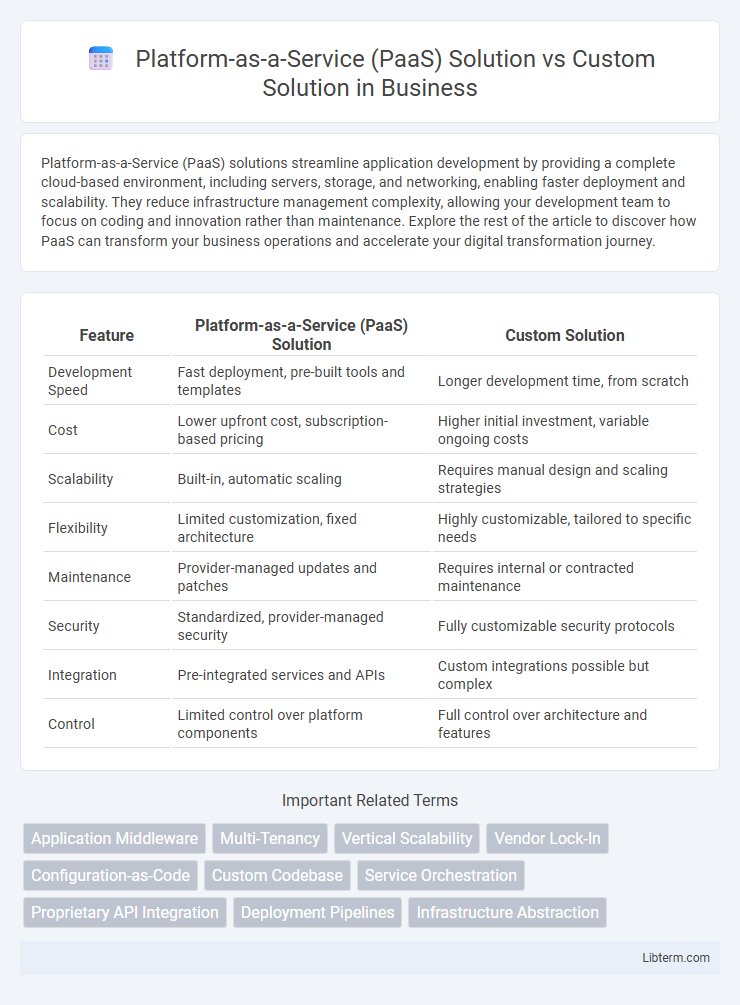Platform-as-a-Service (PaaS) solutions streamline application development by providing a complete cloud-based environment, including servers, storage, and networking, enabling faster deployment and scalability. They reduce infrastructure management complexity, allowing your development team to focus on coding and innovation rather than maintenance. Explore the rest of the article to discover how PaaS can transform your business operations and accelerate your digital transformation journey.
Table of Comparison
| Feature | Platform-as-a-Service (PaaS) Solution | Custom Solution |
|---|---|---|
| Development Speed | Fast deployment, pre-built tools and templates | Longer development time, from scratch |
| Cost | Lower upfront cost, subscription-based pricing | Higher initial investment, variable ongoing costs |
| Scalability | Built-in, automatic scaling | Requires manual design and scaling strategies |
| Flexibility | Limited customization, fixed architecture | Highly customizable, tailored to specific needs |
| Maintenance | Provider-managed updates and patches | Requires internal or contracted maintenance |
| Security | Standardized, provider-managed security | Fully customizable security protocols |
| Integration | Pre-integrated services and APIs | Custom integrations possible but complex |
| Control | Limited control over platform components | Full control over architecture and features |
Introduction to Platform-as-a-Service (PaaS) Solutions
Platform-as-a-Service (PaaS) solutions provide scalable cloud environments that enable developers to build, test, and deploy applications without managing underlying infrastructure. These platforms offer integrated tools, pre-configured frameworks, and automated workflows, significantly accelerating development cycles and reducing operational complexity. Compared to custom solutions, PaaS delivers faster deployment and cost-efficiency by leveraging standardized services and eliminating the need for extensive in-house infrastructure management.
What Is a Custom Software Solution?
A custom software solution is a tailor-made application designed specifically to meet the unique requirements of a business, offering flexibility and scalability beyond standard platforms. Unlike Platform-as-a-Service (PaaS) solutions, which provide pre-built tools and environments for rapid development, custom software is developed from the ground up to align precisely with organizational workflows and goals. This bespoke approach enhances integration capabilities, user experience, and competitive advantage by addressing specific challenges that off-the-shelf or PaaS solutions may not effectively solve.
Key Differences Between PaaS and Custom Solutions
Platform-as-a-Service (PaaS) solutions offer pre-configured environments with scalable infrastructure, rapid deployment, and built-in tools, reducing development time and operational overhead. Custom solutions provide tailored applications designed specifically to unique business requirements, offering maximum flexibility, control, and the ability to implement proprietary features. Key differences lie in PaaS's standardized, cost-effective approach versus custom solutions' customized, resource-intensive development process.
Cost Comparison: PaaS vs Custom Development
Platform-as-a-Service (PaaS) solutions typically offer predictable subscription pricing models that reduce upfront capital expenditure compared to custom development, which demands significant initial investment in design, coding, and infrastructure setup. PaaS minimizes ongoing maintenance and operational costs through managed services, while custom solutions incur higher long-term expenses due to dedicated support, updates, and scalability challenges. Cost efficiency in PaaS arises from shared resources and faster deployment, contrasting with the variable and often higher total cost of ownership associated with bespoke software development.
Time to Market: Speed of Deployment
Platform-as-a-Service (PaaS) solutions significantly reduce time to market by providing pre-built infrastructure, frameworks, and tools that accelerate application development and deployment. Custom solutions require extensive coding, testing, and integration, resulting in longer development cycles and delayed launch timelines. Choosing PaaS enables faster scalability, rapid prototyping, and quicker updates, facilitating a more agile response to market demands compared to bespoke software development.
Scalability and Flexibility Considerations
Platform-as-a-Service (PaaS) solutions offer built-in scalability with automated resource management, enabling businesses to handle fluctuating workloads without manual intervention. Custom solutions provide tailored flexibility, allowing developers to design scalable architectures specific to unique business requirements but often require more complex management and maintenance. Scalability in PaaS is typically faster to implement due to pre-configured infrastructure, whereas custom solutions demand in-depth planning to ensure both scalability and flexibility align with long-term organizational goals.
Security and Compliance Factors
Platform-as-a-Service (PaaS) solutions offer built-in security features and compliance certifications such as ISO 27001, SOC 2, and GDPR compliance that streamline adherence to industry standards. Custom solutions require dedicated investment in security infrastructure, ongoing vulnerability assessments, and tailored compliance strategies to meet specific regulatory requirements. Choosing between PaaS and custom solutions depends on the organization's capacity to manage complex security controls and maintain continuous compliance monitoring.
Maintenance and Support Requirements
Platform-as-a-Service (PaaS) solutions typically offer built-in maintenance and support managed by the service provider, reducing the burden on internal IT teams and ensuring timely updates, security patches, and scalability. Custom solutions demand dedicated internal or third-party resources for ongoing maintenance, troubleshooting, and software upgrades, which may increase operational costs and require specialized expertise. Effective support strategies for custom solutions include establishing comprehensive documentation, regular code audits, and monitoring systems to proactively address issues and enhance system reliability.
Use Cases: When to Choose PaaS or Custom Solutions
PaaS solutions excel in rapid application development, scalability, and integration for startups and businesses needing quick deployment with limited IT resources, especially in web and mobile app projects or prototyping environments. Custom solutions are best for enterprises requiring highly specialized features, strict compliance, or unique workflows that off-the-shelf platforms cannot accommodate, such as complex supply chain management or tailored financial systems. Choosing PaaS minimizes infrastructure management and accelerates time-to-market, whereas custom development offers full control and flexibility for distinctive business demands.
Conclusion: Making the Right Choice for Your Business
Selecting between a Platform-as-a-Service (PaaS) solution and a custom solution depends on business goals, budget, and scalability needs. PaaS offers rapid deployment, lower upfront costs, and built-in infrastructure, ideal for startups and agile projects. Custom solutions provide tailored functionality and complete control, suitable for enterprises requiring unique features and long-term flexibility.
Platform-as-a-Service (PaaS) Solution Infographic

 libterm.com
libterm.com